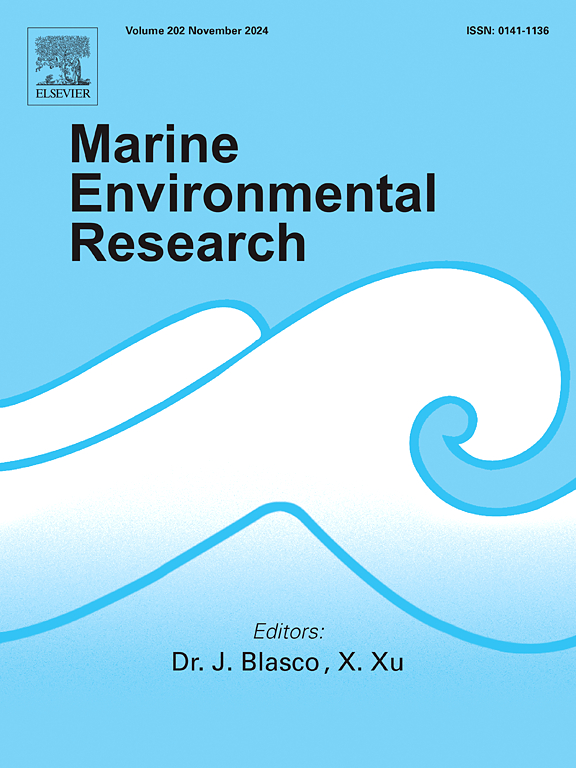Copper-induced microstructural alterations in the chitin-protein matrix and calcium dissolution in the exoskeletal carapace of the mud crab Scylla serrata
IF 3
3区 环境科学与生态学
Q2 ENVIRONMENTAL SCIENCES
引用次数: 0
Abstract
Understanding the exoskeletal microstructural alterations is important for assessing the broader implications of metal pollution on crustacean aquaculture systems. Through this investigation, we seek to contribute valuable insights into the harmful effects of copper pollution on Scylla serrata and inform better management practices in crustacean culture. Current study reveals that copper exposure induces calcium carbonate dissolution from the exoskeleton especially from the endocuticle and the subsequent irreversible microstructural alterations finally lead to the broken mode of the exoskeleton. The field emission scanning electron microscope (FE-SEM) images of copper exposed crab shells show that the reduction of the size of epicuticular spines (3 ± 1.23 μm), decreased surface roughness and the presence of arc or necking pattern of chitin fibers in the endocuticle were observed, indicating the loss of stiffness and structural integrity. The attenuated total reflectance fourier transform infrared spectrophotometer (ATR-FTIR), X-ray diffraction analysis (XRD) and energy dispersive X-ray analysis (EDX) confirmed that these alterations in crab shells are due to the calcium dissolution, copper incorporation and micro precipitation. These findings underscore the adverse effects of copper on the structural integrity of crab shells and provide crucial insights into understanding the need for improved practices to protect aquaculture systems from metal pollution.

铜诱导泥蟹Scylla serrata外骨骼壳中几丁质蛋白基质和钙溶出的微结构改变
了解外骨骼微观结构的变化对于评估金属污染对甲壳类水产养殖系统的广泛影响是重要的。通过这项调查,我们试图为铜污染对锡拉的有害影响提供有价值的见解,并为甲壳类动物养殖提供更好的管理实践。目前的研究表明,铜暴露诱导碳酸钙从外骨骼特别是从鞘内溶解,随后的不可逆微结构改变最终导致外骨骼的断裂模式。对铜暴露的蟹壳进行场发射扫描电镜(FE-SEM)观察发现,蟹壳的角质层棘减小(3±1.23 μm),表面粗糙度降低,鞘内几丁质纤维呈弧形或颈缩状,刚度和结构完整性下降。衰减全反射傅里叶变换红外分光光度计(ATR-FTIR)、x射线衍射分析(XRD)和能量色散x射线分析(EDX)证实,这些变化是由于钙溶解、铜掺入和微沉淀所致。这些发现强调了铜对蟹壳结构完整性的不利影响,并为了解改进做法以保护水产养殖系统免受金属污染的必要性提供了重要见解。
本文章由计算机程序翻译,如有差异,请以英文原文为准。
求助全文
约1分钟内获得全文
求助全文
来源期刊

Marine environmental research
环境科学-毒理学
CiteScore
5.90
自引率
3.00%
发文量
217
审稿时长
46 days
期刊介绍:
Marine Environmental Research publishes original research papers on chemical, physical, and biological interactions in the oceans and coastal waters. The journal serves as a forum for new information on biology, chemistry, and toxicology and syntheses that advance understanding of marine environmental processes.
Submission of multidisciplinary studies is encouraged. Studies that utilize experimental approaches to clarify the roles of anthropogenic and natural causes of changes in marine ecosystems are especially welcome, as are those studies that represent new developments of a theoretical or conceptual aspect of marine science. All papers published in this journal are reviewed by qualified peers prior to acceptance and publication. Examples of topics considered to be appropriate for the journal include, but are not limited to, the following:
– The extent, persistence, and consequences of change and the recovery from such change in natural marine systems
– The biochemical, physiological, and ecological consequences of contaminants to marine organisms and ecosystems
– The biogeochemistry of naturally occurring and anthropogenic substances
– Models that describe and predict the above processes
– Monitoring studies, to the extent that their results provide new information on functional processes
– Methodological papers describing improved quantitative techniques for the marine sciences.
 求助内容:
求助内容: 应助结果提醒方式:
应助结果提醒方式:


